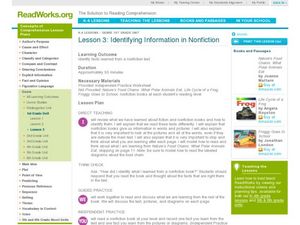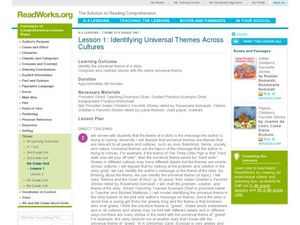Curated OER
Sorting Into Two Groups
Here is a way for your charges to sort pictures of children into 2 groups and put a title for each group. In this classification lesson plan, learners explain why they chose to separate the children the way they did.
Curated OER
Comparing and Contrasting
Introduce your class to the concept of comparing and contrasting with this lesson. After modeling a Venn diagram, help your students find the similarities and differences between two pictures. They can then work on their own Venn...
Curated OER
Identifying Missing Words
How do you figure out the meaning of a word you don't know? Young readers develop skills to identifying missing words in a story using context clues. Picture clues are used to identify covered words in the story I Can’t Get My Turtle to...
Curated OER
Understanding a Story
Reading comprehension is the name of the game! After listening to the teacher model and share personal prior knowledge about small children and what they do with food, the class discusses how they too can use prior knowledge to...
Curated OER
Purposes of Reading Fiction and Nonfiction
How does the purpose of a fiction book differ from the purpose on a non-fiction text? Model for your young readers a scenario in which each kind of book might be useful or fun to read and show examples of each genre. A list of suggested...
Curated OER
Identifying Information in Nonfiction
Second graders investigate information in non-fiction texts. They review the features of a non-fiction text and read the book Nature's Food Chains: What Polar Animals Eat. Pupils discuss the text features and write down one fact they...
Curated OER
Lesson 3: Labeled Diagrams
Examine the book Stargazers by Gail Gibbons. Young readers will practice reading and interpreting information from diagrams in this informational text. They work together as a class on this skill and then move into independent practice....
Curated OER
The Best Main Idea
What is the main idea? Interest your young readers with this fun introductory instructional activity! After selecting several items from a paper bag, the teacher leads learners to determine the big idea for those items. This concept is...
Curated OER
Identifying Setting Using Evidence from the Text
Help young readers find the setting in the story. They will review what a setting is with a modeled example by the teacher. After reading The Cow Who Wouldn't Come Down by Paul Brett Johnson and completing a practice sheet, they will be...
Curated OER
Visual and Meaning Cues
Learn how to apply visual and meaning cues to reading unknown words. Readers will explore what to do when they come to a word they do not know as they watch the teacher model the use of these cues and then participate in guided and...
Curated OER
Structure and Meaning Cues
First graders use cues to identify unknown words. They will learn strategies to assist them in decoding while reading. Then they discuss how to listen to themselves read in order to decide whether or not the word makes sense in the...
Curated OER
Predicting Actions
Analyze and predict a character's actions in a text by reading the book Julius, Baby of the World and discussing the character's personality. Individuals use a character action chart to record their actions throughout the story, and then...
Curated OER
Using Compare and Contrast Key Words
Compare and contrast while challenging your class with this higher-level thinking and reading comprehension lesson. After observing the teacher model comparing and contrasting bats and birds, learners read passages about two towns. They...
Curated OER
Lesson 3: Idioms
You're as cute as a bug. But are you really as cute as a bug? Bugs aren't cute! Idioms are fun nonliteral phrases that mean something different than the words they contain. Second graders learn about idioms as they read the book, More...
Curated OER
Characteristics of Nonfiction
The second lesson in a series from ReadWorks.org, this lesson continues to explore the difference between fiction and nonfiction texts. The lesson opens with the teacher reviewing a class Venn diagram started in the last lesson....
Curated OER
How Characters Affect the Plot
How do a character’s feelings and actions influence the plot of a story? The interaction between character and plot is explored in this lesson plan that uses When Charlie McButton Lost Power to launch the discussion. Charlie’s love of...
Curated OER
Which Story Matches the Given Theme?
Model for young learners how to determine the theme of a story. Read aloud Aesop’s The Fox and the Stork. Chart the plot and the main idea of the fable, showing class members how these elements support the theme. Fable titles for guided...
Curated OER
Lesson 2:Context Clues
Using The Life Cycle of an Emperor Penguin by Bobbie Kalman, second graders practice defining unfamilar words with context clues. They come across new vocabulary words and read the entire sentence and the sentence before to find the...
Curated OER
Lesson 3: Distinguishing the Author's Purpose
It is true that the more you practice something, the better you'll get at doing it. Lesson three in a three part series on author's purpose has kids venture out to determine the author's purpose in three different passages. They'll read...
Read Works
Signal Words in Expository Text
Signal words are one way that authors make the relationships between their ideas clear. Allow your learners the chance to investigate cause and effect in texts by identifying signal words. They locate and analyze cause-and-effect...
Curated OER
Antagonist
Young learners explore the antagonist. They retell Hansel and Gretel and identify the witch and the stepmother as antagonists. They then brainstorm common character traits of an antagonist, and then write a paragraph describing an...
Curated OER
Strategies for Identifying Genres
Examine the different strategies that could be used to determine what genre something is with upper graders. They will learn that knowing the genre type can sometimes help their comprehension. They will also complete a worksheet to help...
Curated OER
Identifying Universal Themes Across Cultures
Have your class read the story "The Magic Lake," retold by Liana Romulo, from Filipino Children's Favorite Stories. Guide them to identify the problem, solution, and universal theme. They compare the theme of this story to the theme of...
Curated OER
Compare and Contrast Author's Voice
Follow the procedural details here to model for your class how to identify author's voice in two poems, "Since Hannah Moved Away" by Judith Viorst and Mirriam Chaikin's "I Hate Harry." Together, determine voice and the words that reveal...

























